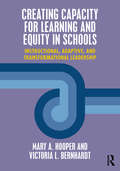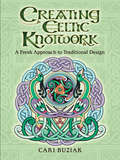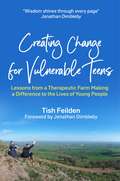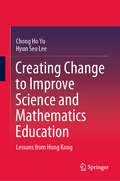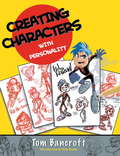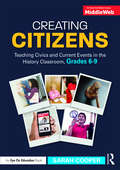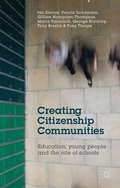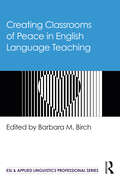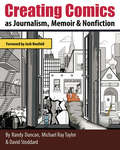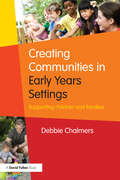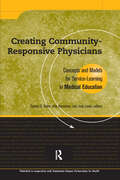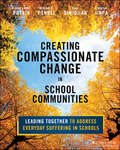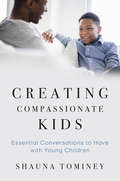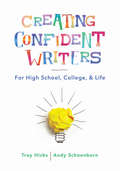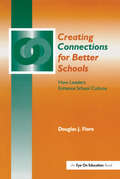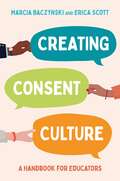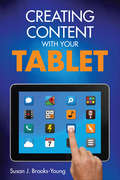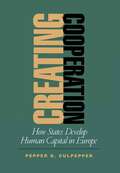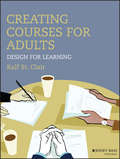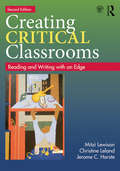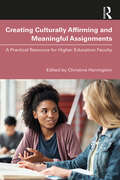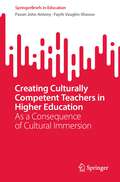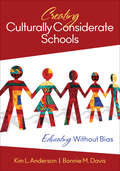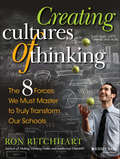- Table View
- List View
Creating Capacity for Learning and Equity in Schools: Instructional, Adaptive, and Transformational Leadership
by Victoria L. Bernhardt Mary A. HooperSuccessful educational leaders develop people, processes, culture, and structures in their schools. Creating Capacity for Learning and Equity in Schools provides a comprehensive guide for aspiring and practicing leaders to strengthen their capacity to create high levels of learning and equity. Chapters explore key theories and research, provide resources for developing personal and organizational leadership capacity, and guide leaders through a reflective process to help them link theory and practice. Hooper and Bernhardt's model for excellence and equity provides a pathway for educators to create and sustain learning communities in schools. Exploring three leadership approaches--Instructional, Adaptive, and Transformational--this textbook prepares and develops leaders to engage school communities through effective instructional leadership, data-informed decision-making, and a vision for learning and equity for all. Special Features: Theory to Practice (T2P) Framework--A series of structured exercises help readers review and reflect on existing organizational practices and develop new action plans. Case Studies--Encourage individual reflection and collective discussion on key leadership scenarios. Examples in Action--Challenge readers to analyze new connections and leadership processes. A companion website--Includes additional resources and tools for instructors to facilitate activities in the classroom.
Creating Celtic Knotwork: A Fresh Approach to Traditional Design (Dover Art Instruction)
by Cari BuziakWhether you're a complete beginner or have already attempted to learn the art of Celtic knotwork, this is the book for you! Artists at all levels will treasure this guide, which not only demonstrates how to duplicate patterns from a rich and varied gallery of examples but also how to take the next step to creating your own unique designs.This newly revised edition of Creating Celtic Knotwork features a wealth of added material and revisions. Author Cari Buziak draws upon her extensive teaching experience to present easy-to-understand, well-illustrated instructions that explain all the basic techniques of Celtic patterns as well as the art's meaning and history. In addition to spirals, mazes, and step patterns, the designs include dragons, hounds, and other animals as well as human forms. Exercises and tips encourage experimentation that will allow you to develop your own variations on traditional forms. Information on drawing tools, painting materials, transferring patterns, and other practical aspects will help you get started right away.
Creating Change for Vulnerable Teens: Lessons from a Therapeutic Farm Making a Difference to the Lives of Young People
by Tish FeildenCreating Change for Vulnerable Teens tells the story of Tish Feilden and Jamie's Farm - a network of therapeutic farms dedicated to transforming the lives of disadvantaged children.Documenting Tish's experiences of working with truly remarkable teens who have faced huge challenges in their lives, the book describes how the farms help young people to thrive academically, socially and emotionally. She shares the approaches they have pioneered, including the critical importance of trust, of looking behind the behaviour and of really connecting with the desires and hopes of young people. If you have an interest in supporting vulnerable children or young people, this book provides a wealth of inspiration and ideas you can use, whatever the setting.
Creating Change to Improve Science and Mathematics Education: Lessons from Hong Kong (Springerbriefs In Education Ser.)
by Chong Ho Yu Hyun Seo LeeThis book discusses the merits and potential shortcomings of Hong Kong STEM education from Grade 8 to Grade 12. Based on concurrent triangulated mixed-method methodology, which integrates both quantitative and qualitative procedures, it describes various change models and proposes new models that are considered compatible with Western cultures.
Creating Characters with Personality
by Glen Keane Tom BancroftFrom Snow White to Shrek, from Fred Flintstone to SpongeBob SquarePants, the design of a character conveys personality before a single word of dialogue is spoken. Designing Characters with Personality shows artists how to create a distinctive character, then place that character in context within a script, establish hierarchy, and maximize the impact of pose and expression. Practical exercises help readers put everything together to make their new characters sparkle. Lessons from the author, who designed the dragon Mushu (voiced by Eddie Murphy) in Disney's Mulan--plus big-name experts in film, TV, video games, and graphic novels--make a complex subject accessible to every artist.
Creating Citizens: Teaching Civics and Current Events in the History Classroom, Grades 6–9
by Sarah CooperEngage students in meaningful civic learning and encourage them to become active and informed citizens. With this essential book, co-published by Routledge and MiddleWeb, you will gain a variety of practical strategies for teaching civics and current events to your middle school students. Author and expert teacher Sarah Cooper takes you into her school and shares her classroom-tested methods and tools.Topics include: Fitting current events into an already-packed history curriculum Staying nonpartisan and fostering balanced discussions Helping students find their stake in the news Teaching civic literacy through primary sources, then and now Encouraging students to invest in analytical writing Fostering student ownership of our classrooms through discussion and debate Cultivating citizenship through empathy and community engagement Throughout the book, you’ll find student examples, handouts, and rubrics, so that you can easily implement the ideas in your own classroom. By getting your students to think critically about current events, you will help them become passionate writers, thinkers, and involved citizens.
Creating Citizenship Communities
by Tony Thorpe Ian Davies Vanita Sundaram Gillian Hampden-Thompson Maria Tsouroufli George Bramley Tony BreslinThis book addresses what is globally acknowledged to be one of the most fundamental and pressing concerns in contemporary society: the ways in which education can help young people understand - and play a full and active part - in contemporary society. On the basis of a national project funded by the Esmee Fairbairn Foundation and conducted as part of a partnership between the National Foundation of Educational Research and the Department of Education at the University of York, UK, the authors analyse data from young people and teachers to explore what they understand by citizenship and community and what they currently do, and would like to do, to promote more effective learning and engagement. On the basis of this research the authors make recommendations to enhance levels of understanding and opportunities for engagement in citizenship communities. "
Creating Classrooms of Peace in English Language Teaching (ESL & Applied Linguistics Professional Series)
by Barbara M. BirchTimely and accessible, this edited volume brings together leading scholars to discuss methods for supporting reconciliation, peace, and sustainable and social change in English language teaching. Around the world, peace and reconciliation are urgent themes that are inextricably connected to the study and practice of teaching English. The book features a diversity of voices and addresses pedagogies of peace, universal responsibility, and global interdependence in the domain of English language education. Organized in three strands, Part 1 addresses policy and implementation, Part 2 addresses teacher education, and Part 3 addresses content and lesson planning. With chapters drawn from a dozen countries and contexts, this book paves the way for English language teachers to harness their social capital and pedagogical agency to create sustainable peace globally and locally, and in and outside the classroom. It is essential reading for scholars and students in TESOL, applied linguistics, and peace education.
Creating Comics as Journalism, Memoir and Nonfiction
by Randy Duncan Michael Ray Taylor David StoddardThis book provides student journalists, artists, designers, creative writers and web producers with the tools and techniques they need to tell nonfiction stories visually and graphically. Weaving together history, theory, and practical advice, seasoned nonfiction comics professors and scholars Randy Duncan, Michael Ray Taylor and David Stoddard present a hands-on approach to teach readers from a range of backgrounds how to develop and create a graphic nonfiction story from start to finish. The book offers guidance on: -how to find stories and make use of appropriate facts and visuals; -nonfiction narrative techniques; -artist's tools and techniques; -print, digital, and multimedia production; -legal and ethical considerations. Interviews with well-known nonfiction comics creators and editors discuss best practices and offer readers inspiration to begin creating their own work, and exercises at the end of each chapter encourage students to hone their skills.
Creating Communities in Early Years Settings: Supporting children and families
by Debbie ChalmersCreating Communities in Early Years Settings encourages and supports all early years practitioners who work with children and their families within the Early Years Foundation Stage. Offering advice, ideas and strategies for developing an early learning community, this book provides clear guidance and real world examples that show how practitioners can provide an excellent, inclusive service to meet the needs of young children and their families and help them to thrive. Debbie Chalmers presents innovative and practical ideas to promote progress, development and inclusion, while outlining potential pitfalls and explaining how to identify and cater for individual needs. Chapters cover key topics such as: the legal responsibilities of a setting inclusion parental participation and parent managed settings roles and duties of different staff within a setting effective and sensitive communication with colleagues and caregivers and managing transitions. Creating Communities in Early Years Settings is designed to support early years practitioners, teachers, teaching assistants, nannies and childminders working with babies and children within the Early Years Foundation Stage. The book will also be of interest to students on early years childcare and education courses from level 2 upwards.
Creating Community-Responsive Physicians: Concepts and Models for Service-Learning in Medical Education
by Sarena D. Seifer, Kris Hermanns, Judy Lewis, Edward ZlotkowskiEighth in AAHE’s Service-Learning in the Disciplines Series, this volume shows how service-learning is not only a strategy for preparing community-responsive and competent health physicians, but also for fostering citizenship and changing the relationship between communities and medical schools. This very useful book provides readers with a valuable source of information and inspiration to develop and expand service-learning across the continuum of medical education.
Creating Compassionate Change in School Communities: Leading Together to Address Everyday Suffering in Schools
by Thupten Jinpa Sona Dimidjian William R. Penuel Ashley Seidel PotvinAddressing everyday suffering in schools through compassion Compassion and dignity provide an essential framework for building caring and inclusive schools. Many books focus on what teachers can do as individuals; Creating Compassionate Change in School Communities is different. This book focuses both on how educators can cultivate compassion within themselves and lead together to cultivate humanizing school environments. Teachers, librarians, counselors, resource specialists, mental health professionals, and social workers who are working to create conditions for compassion and dignity in schools are all leaders who can impact change. Offering concrete evidence and case studies that showcase the power of compassion to create flourishing school communities and rejuvenate education, the book will help all educators better serve K-12 students with school cultures that promote healing. Compassion can be cultivated, dignity can be affirmed, and leaders need skillful means to do so—tools and practices that can help them develop compassion for themselves and others and see their own dignity and that of others. Experiment and engage in meditation practices to strengthen personal capacity for mindfulness and compassion and the application to the classroom and school communities Engage in hands-on writing exercises and self-reflection questions educators can ask themselves and then apply their personal growth to influence school policies and climate Gain perspective on compassion in schools through a multidisciplinary lens drawing from contemplative practices, psychology, and organizational change theory Learn from stories and examples of K-12 educators who have exemplified compassion in action While we cannot fully address all the suffering that is happening in schools today, educators do have the power to work within themselves and together locally to create more compassionate responses to suffering and to affirm the dignity of all members of their school communities. Creating Compassionate Change in School Communities offers a valuable approach to integrating wellness into schools, as much for principals and superintendents as for teacher leaders, librarians, counselors, resource specialists, and others who work to create the conditions for compassion and dignity in their school.
Creating Compassionate Kids: 50 Essential Conversations To Have With Young Children
by Shauna TomineyYoung children can surprise us with tough questions. Tominey’s essential guide teaches us how to answer them and foster compassion along the way. If you had to choose one word to describe the world you want children to grow up in, what would it be? Safe? Understanding? Resilient? Compassionate? As parents and caregivers of young children, we know what we want for our children, but not always how to get there. Many children today are stressed by academic demands, anxious about relationships at school, confused by messages they hear in the media, and overwhelmed by challenges at home. Young children look to the adults in their lives for everything. Sometimes we’re prepared... sometimes we’re not. In this book, Shauna Tominey guides parents and caregivers through how to have conversations with young children about a range of topics-from what makes us who we are (e.g., race, gender) to tackling challenges (e.g., peer pressure, divorce, stress) to showing compassion (e.g., making friends, recognizing privilege, being a helper). Talking through these topics in an age-appropriate manner—rather than telling children they are too young to understand—helps children recognize how they feel and how they fit in with the world around them. This book provides sample conversations, discussion prompts, storybook recommendations, and family activities. Dr. Tominey's research-based strategies and practical advice creates dialogues that teach self-esteem, resilience, and empathy: the building blocks for a more compassionate world.
Creating Confident Writers: For High School, College, And Life
by Troy Hicks Andy SchoenbornWriting should be for an audience other than a teacher, and for a purpose beyond getting a grade. Connecting their classroom experience to research about writing, as well as to framing documents in the field, two seasoned writing teachers distill the lessons they’ve learned about creating confident adolescent and young adult writers. Troy Hicks and Andy Schoenborn outline a fundamental stance to their approach—to invite, encourage, and celebrate students’ writing—that is then echoed in the book’s three-part structure. There are numerous classroom activities and assignments on topics from creating writing goals to supporting revision, examples of student work, and questions to guide teachers’ reflections. In this book for any teacher of writing, from middle school through college, readers are invited to try strategies and allow students’ voices to emerge, while discussing with colleagues how these approaches might work for them, too.
Creating Connections for Better Schools: How Leaders Enhance School Culture
by Douglas FioreThis book demonstrates that student achievement depends on school culture, the one element of your school at the foundation of everything that happens there. School culture is the system of beliefs, values, and expectations that governs the feelings and actions of everybody there. This book shows how principals can build relationships and connections to enhance school culture. Practical and accessible, this book provides guidelines which will show you how to:- communicate with teachers, students, and parents on a regular basis - be "visible" - recognize, utilize and empower your faculty
Creating Consent Culture: A Handbook for Educators
by Marcia Baczynski Erica ScottCan you imagine a world where no one feared a violation of their boundaries? A world where everyone felt safe in their bodies and confident in asking for what they wanted? Teaching consent education is the way to achieve this vision, and this entry level book for educators helps you teach and discuss consent issues to young adults, from 10+.The fun, interactive exercises in this book focus on consent in all interactions, not just sexual ones, and explores skills that help young people to increase their relational intelligence and build positive, reciprocal relationships.Drawing on their combined experiences of over 25 years as consent educators, the authors have seen that more respectful, generous and joyful ways of relating to one another are possible. In this vital book, they challenge common assumptions about consent and coercion, and invite educators of all walks to become instigators of a profound culture shift.
Creating Content With Your Tablet
by Susan J. Brooks-YoungTransform students from content consumers to content creators! This comprehensive guide gets to the heart of effective mobile technology use in today’s classroom. Internationally recognized education expert Susan Brooks-Young provides manageable, research-based strategies to help teachers and administrators: Confidently plan and manage mobile technology activities across grade levels Explore new uses and applications for multiple devices Use rubrics and checklists to evaluate appropriate, cross-platform educational apps Manage content-specific tablet use in learning centers or small groups Tap student ingenuity and improve critical thinking skills Time-saving tips cover a wide range of apps to help busy teachers easily incorporate tablets into daily classroom use. Includes step-by-step instructions across content areas for digital photography, video, ePublishing, QR codes and more. Transform students from content consumers to content creators with this must-have resource! "Creating Content With Your Tablet provides educators with simple, easy steps to implement tablet technology with the Common Core Standards. I am encouraged to try the apps in this book. It makes the connection between modern technology and what teachers are already doing in the classroom seem seamless." —Michelle Strom, Language Arts Teacher Fort Riley Middle School, KS "Very practical. The discussion questions at the end of each chapter are excellent for a book study or district that is moving towards tablet implementation." —David Fife, Vice Principal Tweedsmuir Public School, London, Ontario, Canada
Creating Content With Your Tablet
by Susan J. Brooks-YoungTransform students from content consumers to content creators! This comprehensive guide gets to the heart of effective mobile technology use in today’s classroom. Internationally recognized education expert Susan Brooks-Young provides manageable, research-based strategies to help teachers and administrators: Confidently plan and manage mobile technology activities across grade levels Explore new uses and applications for multiple devices Use rubrics and checklists to evaluate appropriate, cross-platform educational apps Manage content-specific tablet use in learning centers or small groups Tap student ingenuity and improve critical thinking skills Time-saving tips cover a wide range of apps to help busy teachers easily incorporate tablets into daily classroom use. Includes step-by-step instructions across content areas for digital photography, video, ePublishing, QR codes and more. Transform students from content consumers to content creators with this must-have resource! "Creating Content With Your Tablet provides educators with simple, easy steps to implement tablet technology with the Common Core Standards. I am encouraged to try the apps in this book. It makes the connection between modern technology and what teachers are already doing in the classroom seem seamless." —Michelle Strom, Language Arts Teacher Fort Riley Middle School, KS "Very practical. The discussion questions at the end of each chapter are excellent for a book study or district that is moving towards tablet implementation." —David Fife, Vice Principal Tweedsmuir Public School, London, Ontario, Canada
Creating Cooperation: How States Develop Human Capital in Europe (Cornell Studies in Political Economy)
by Pepper D. CulpepperIn Creating Cooperation, Pepper D. Culpepper explains the successes and failures of human capital reforms adopted by the French and German governments in the 1990s. Employers and employees both stand to gain from corporate investment in worker skills, but uncertainty and mutual distrust among companies doom many policy initiatives to failure. Higher skills benefit society as a whole, so national governments want to foster them. However, business firms often will not invest in training that makes their workers more attractive to other employers, even though they would prefer having better-skilled workers. <p><p>Culpepper sees in European training programs a challenge typical of contemporary problems of public policy: success increasingly depends on the ability of governments to convince private actors to cooperate with each other. In the United States as in Europe, he argues, policy-makers can achieve this goal only by incorporating the insights of private information into public policy. Culpepper demonstrates that the lessons of decentralized cooperation extend to industrial and environmental policies. In the final chapter, he examines regional innovation programs in the United Kingdom and the clean-up of the Chesapeake Bay in the United States―a domestic problem that required the coordination of disparate agencies and stakeholders.
Creating Courses for Adults
by Ralf St. ClairBecome an effective adult educator by approaching teaching systematicallyAs the author describes at the beginning of Creating Courses for Adults, "The big idea of this book is that education for adults has to be designed." Whether in basic skills training, English language classes, professional development workshops, personal interest courses, or formal degree programs, good teaching tends to conceal all the planning and decisions which had to be made in order to present participants with a seamless and coherent process for learning. The author posits that nobody is a completely intuitive teacher and that everybody has to make a series of choices as they put courses together. The decisions they make are important and far-reaching, and deserve to be considered carefully.Starting with the three core factors which must be taken into account when creating courses, Creating Courses for Adults walks readers through a manageable process for addressing the key decisions which must be made in order to design effective learning.Instructor factors are what the teacher brings to the teaching and learning process, such as experience and preferences.Learner factors are the influences that students bring with them, including their past experiences and expectations for the class.Context factors include the educational setting, whether in-person or online, as well as the subject matter.Readers of Creating Courses for Adults will learn a systematic approach to lesson and course design based on research into the ways adults learn and the best ways to reach them, along with pointers and tips for teaching adults in any setting.
Creating Critical Classrooms: Reading and Writing with an Edge
by Jerome C. Harste Christine Leland Mitzi LewisonThis popular text articulates a powerful theory of critical literacy—in all its complexity. Critical literacy practices encourage students to use language to question the everyday world, interrogate the relationship between language and power, analyze popular culture and media, understand how power relationships are socially constructed, and consider actions that can be taken to promote social justice. By providing both a model for critical literacy instruction and many examples of how critical practices can be enacted in daily school life in elementary and middle school classrooms, Creating Critical Classrooms meets a huge need for a practical, theoretically based text on this topic. Pedagogical features in each chapter • Teacher-researcher Vignette • Theories that Inform Practice • Critical Literacy Chart • Thought Piece • Invitations for Disruption • Lingering Questions New in the Second Edition • End-of-chapter "Voices from the Field" • More upper elementary-grade examples • New text sets drawn from "Classroom Resources" • Streamlined, restructured, revised, and updated throughout • Expanded Companion Website now includes annotated Classroom Resources; Text Sets; Resources by Chapter; Invitations for Students; Literacy Strategies; Additional Resources
Creating Culturally Affirming and Meaningful Assignments: A Practical Resource for Higher Education Faculty
by Christine HarringtonCreating Culturally Affirming and Meaningful Assignments offers principles, strategies, and examples to aid in the development of inclusive college coursework in which all students feel seen and valued. This resource prepares instructors to proactively consider ways to honor and engage with students’ varied identities and lived experiences through assignments. Chapters cover the course design process, methods on getting to know your students, assignment options beyond the exam, and more. Reflection questions at the end of each chapter serve as a springboard for faculty and leadership conversations on equitable and inclusive teaching practices, while the appendix features 20 example assignments sourced from various higher education disciplines. An accessible, practical read, this guidebook is for any higher education instructor who wants to reimagine their assignments to center and celebrate students’ varied cultural backgrounds and experiences.
Creating Culturally Competent Teachers in Higher Education: As a Consequence of Cultural Immersion (SpringerBriefs in Education)
by Pavan John Antony Fayth Vaughn-ShavuoThis book presents evidence of a longitudinal study in teacher preparation utilizing a threefold multicultural (TFM) model of immersion. It establishes the need for culturally responsive teachers in classrooms, and outlines a proven model that can be employed to prepare them.Through the TFM model elements, pre-service teacher candidates participated in class-based, cohort fieldwork experience, and reflective journal writings and discussions. Evidence was gathered from pre- and post-questionnaires, interviews, classroom discussions, and journal writings, along with the inclusion of student voices. Pre-service teacher attitudes, beliefs, and degree of cultural responsiveness changed post-study, and candidates became more effective in the classroom, highlighting the effectiveness of the TFM model.This book is an invaluable resource for universities, under- and postgraduate students, and teachers across the globe as it provides a teacher preparation fieldwork model that helps to prepare culturally responsive teachers for children in any classroom.
Creating Culturally Considerate Schools: Educating Without Bias
by Kim L. Anderson Bonnie M. DavisAre you seeing your students clearly? This unique collaboration between a veteran educator and a psychotherapist asserts that the educators who are most effective in teaching diverse populations are those who can "see students clearly and respond to their needs without hesitation or bias." Framed around an original, eight-stage model of diversity development, this book provides readers with essential tools for building a sturdy foundation of mutual respect. Included are specific strategies for creating a school environment that: Gives voice and consideration to all students Shows interest, empathy, and respect for all staff members Advocates respect and reverence of individuality
Creating Cultures of Thinking
by Ron RitchhartDiscover why and how schools must become places where thinking is valued, visible, and actively promoted As educators, parents, and citizens, we must settle for nothing less than environments that bring out the best in people, take learning to the next level, allow for great discoveries, and propel both the individual and the group forward into a lifetime of learning. This is something all teachers want and all students deserve. In Creating Cultures of Thinking: The 8 Forces We Must Master to Truly Transform Our Schools, Ron Ritchhart, author of Making Thinking Visible, explains how creating a culture of thinking is more important to learning than any particular curriculum and he outlines how any school or teacher can accomplish this by leveraging 8 cultural forces: expectations, language, time, modeling, opportunities, routines, interactions, and environment. With the techniques and rich classroom vignettes throughout this book, Ritchhart shows that creating a culture of thinking is not about just adhering to a particular set of practices or a general expectation that people should be involved in thinking. A culture of thinking produces the feelings, energy, and even joy that can propel learning forward and motivate us to do what at times can be hard and challenging mental work.
